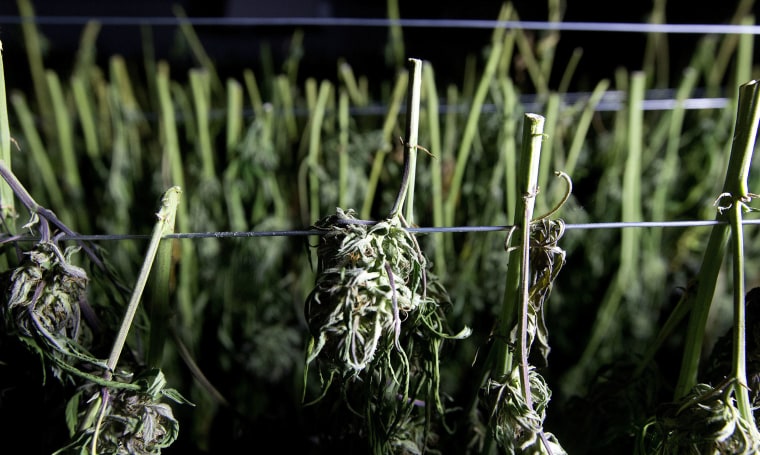2018 has been a banner year for the legal marijuana industry, as the national market for weed skyrocketed and five more states legalized it, reflecting widespread popular support.
This year, Vermont and Michigan became the ninth and 10th states to legalize recreational marijuana, which is also legal In the District of Columbia. And voters in Missouri, Oklahoma and Utah overwhelmingly approved ballot measures making medical marijuana legal. That means 33 states plus D.C. now approve the illicit drug for medical use, raising the question of whether the U.S. will follow Canada’s lead in legalizing marijuana nationwide.
In 2019, legalization for recreational use seems imminent in New York and New Jersey.
The wave of legalization is taking place as the latest polls show that nearly two-thirds of Americans endorse it, double the rate in 2000. Investors are noticing too, pouring an estimated $10 billion into the industry in North America this year.
Still, medical researchers continue to caution against its use because little is known about its effects on health. Here is a review of what we’ve learned about marijuana and marijuana-based products in 2018.
Today’s weed stronger than yesterday’s
Tetrahydrocannabinol, or THC, is the main psychoactive ingredient in marijuana and typically used as a measure of potency. Over the past decade, the quantity of THC in marijuana in the United States has risen steadily, and the change has been more dramatic where there is a legal market.
A study published in 2016 tested over 38,000 samples of marijuana seized by the Drug Enforcement Administration from 1995 to 2014. The average THC content in 1995 was around 4 percent. By 2014, it had risen to 12 percent.

One legal market is in Washington state. “The average potency of the flower product sold in Washington’s state-licensed markets is over 20 percent, and the average potency of extract-based products — like oils for vaping pens, dabs and the like — is in the neighborhood of 70 percent,” said Jonathan Caulkins, a drug policy researcher and professor at Carnegie Mellon University.
Pot use affects teens’ thinking ability
“Our studies have found that cannabis causes cognitive impairment and delayed cognitive development in adolescents," said Patricia Conrod, professor of psychiatry at the University of Montreal and a longtime researcher on marijuana and the brain.
A study published in the American Journal of Psychiatry found that marijuana had a more damaging effect on teenagers’ long-term cognitive abilities than alcohol. Even after students reported stopping, their cognition did not improve.
“It’s important that we study the neuropsychological effects of cannabis because it is linked directly to how someone functions in life,” said Conrod.
It's not the first research to find that cannabis use can harm teenage brains.
In a study published in JAMA Psychiatry in June, University of Pennsylvania scientists analyzed 69 studies involving younger cannabis users. They discovered that young people who used marijuana frequently were more likely than non-users to have slightly lower scores on tests of memory, learning new information, and higher-level thinking involving problem solving and processing.
Chronic pot smoking may be addictive
Studies have shown that chronic marijuana use affects the same brain structures that are involved with addiction.
The National Institute on Drug Abuse suggests that 30 percent of those who use marijuana may have some degree of “marijuana use disorder.”
Marijuana use disorders are often associated with dependence — in which a person feels withdrawal symptoms when not taking the drug. It occurs when the brain adapts to large amounts of the drug, requiring more and more to create the desired euphoric effect. Withdrawal symptoms include irritability, mood and sleep difficulties, decreased appetite, cravings, restlessness and physical discomfort that peak within the first week after quitting and last up to two weeks.
CBD proves effective for epilepsy
In June, the Food and Drug Administration approved Epidiolex, a purified form of cannibidiol, a non-psychoactive component of cannabis, to treat rare and severe forms of epilepsy in kids — the first marijuana-based pharmaceutical to help remedy the condition. The drug doesn’t contain the THC that gets recreational users high.
The FDA acknowledged that this was a significant advancement in finding proven and safe medical uses for marijuana-based products.
“The difficult-to-control seizures that patients with Dravet syndrome and Lennox-Gastaut syndrome experience have a profound impact on these patients’ quality of life,” said the FDA’s Dr. Billy Dunn.
“In addition to another important treatment option for Lennox-Gastaut patients, this first-ever approval of a drug specifically for Dravet patients will provide a significant and needed improvement in the therapeutic approach to caring for people with this condition.”
The marijuana research horizon for 2019
Caulkins believes that more research needs to be done to see how the stronger newer strains of pot affect the body.
Researchers also believe that medical marijuana may be a way to curb opioid use. Opioid overdoses have risen dramatically in recent years and have been implicated in over 500,000 deaths from 2000 to 2015 — more than the number of Americans killed in World War II.
Two recent studies suggest that there is merit to that strategy.
The studies, published in the journal JAMA Internal Medicine, found that states that allow the use of cannabis for medical purposes had 2.1 million fewer daily doses of opioids prescribed per year under Medicare Part D, compared with those states without medical cannabis laws.
And opioid prescriptions under Medicaid also dropped by nearly 6 percent in states with medical cannabis laws compared with states without such laws, according to the studies.





